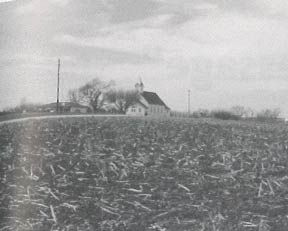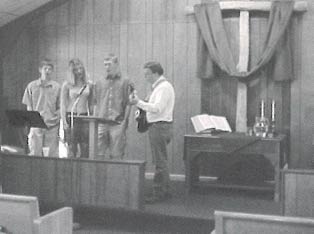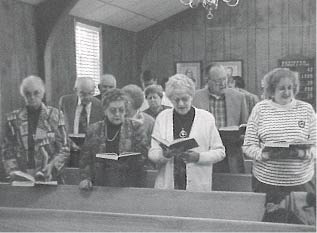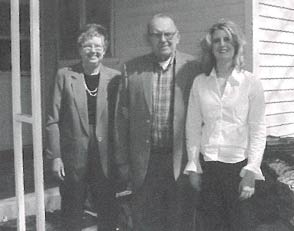Updated April, 2025
For more than a century, people have gathered for worship each Sunday at Rose Valley, a small rural church set in the quiet beauty of the Kansas prairie. Rose Valley consists of a small white frame church built in 1901 and a parsonage that was added in 1917. Named for the wild roses that still grow in the area, the church began with settlers who were eager to teach their children the Christian faith. First came the Sunday school, then the church.
Today Rose Valley has no children and three teenagers. Most of the members are elderly; new members are rare. Just as the family farm has been disappearing, so have countless rural churches. Families continue to leave for towns and cities, and young people leave for college and settle elsewhere.
But that small community of faith has deep roots, and they worship in hopes of maintaining their fellowship together as a congregation. On the Sunday I was there, a young couple was celebrating their first wedding anniversary; the whole congregation was celebrating with them.

Ecumenical Connections
Five miles away on Route 24 in north central Kansas, close to the geographic center of the United States, is Downs—a town of about a thousand people. Downs has a grain elevator, a water tower, a thriving annual storytelling festival, and five churches of five different denominations, plus Rose Valley and Dispatch Christian Reformed Church, another rural church eight miles away. Dispatch Church has a thriving young peoples’ group that welcomes youth from other churches.
These people know each other and what goes on in each other’s churches. Each congregation appoints a reporter, who records remarkably detailed accounts of every service published each week in the Downs News & Times. All the churches, Catholic and Protestant, take turns hosting Wednesday noon Lenten services, which are followed by a light lunch. If the stores aren’t open again by 1:00, no one worries about it; everyone knows where people are. A simple spirit of ecumenical and neighborly cooperation binds the whole Christian community together.

Everyone Counts
Rose Valley United Methodist has not had a full-time pastor for some time; currently a retired pastor provides leadership. On the plus side, belonging to a small congregation gives many members the chance to be involved in leadership roles, as is evident in the outline of the service I attended (see sidebar). Some things haven’t changed in a long time. Pew racks hold King James Bibles and The New Church Hymnal, a hymnal from the 1970s. But worshipers also sing from copies of the Maranatha! Praise Chorus Book, often accompanied by guitar. An active committee meets to plan worship. Every year during Advent and Lent they choose one of the service planning series from Reformed Worship. Worship leaders and song leaders rotate on a monthly basis; others read Scripture. The church used to have a children’s message and didn’t want to drop it even though there were no children, so instead they include a “Faith/Lenten moment,” when someone reads a portion of Scripture, or a short meditation based on the theme of the service.
To understand this community, it’s necessary to attend both the worship service and Sunday school—virtually everyone does. In worship, they receive God’s Word; in Sunday school, they study God’s Word. Everyone meets together first, with more announcements, celebration of birthdays and anniversaries, reports on mission work, and then dismissal into classes by age level. Again, there were many opportunities for leadership in the various classes.
I left Rose Valley Church with a grateful heart that such faithful persistence continues in the face of a dwindling population. Love for God and for the beauty of the prairie sustains their fellowship. These people love to be together, and they have nurtured love for community in those that have left to become part of other communities of faith in other parts of the country and around the world.


The Second Sunday in Lent
The Gathering
Prelude
[The three high school students sang choruses, accompanied on guitar by Carl Warner, the song leader for the service. Then a pianist played a brief prelude.]
Welcome
[Worship leader Gary Doane welcomed by name those who had been absent because of illness or travel and made sure visitors were named and welcomed. On this day, the visitors included a graduate student who was visiting her grandfather, who had had a stroke (see box at top).]
Invocation
Singing
“Standing on the Promises”
“Great Is Thy Faithfulness”
[A time for announcements followed; ministry opportunities mentioned were global in scope, from local Bible studies to Nigerian missions. The welcome and announcements were followed by a prayer asking for the Spirit’s leading during the service. The song leader introduced the songs with brief comments linking the text to the focus of the service. The songs were accompanied by guitar as well as piano and organ. The church has four pianists, a couple of whom also play organ.]
Prayer Concerns and Testimonies
Congregational Prayer
[Two people stood to give thanks for restored health; prayers were requested for someone near death, a member of the Lutheran church in the nearest town. Sometimes this part of the service is quite extended. The pastor then led in the congregational prayer, ending with everyone saying the Lord’s Prayer.]
Scripture Reading
Gloria Patri
Lenten/Faith Moment
[Two Scripture passages (from the Psalms and from John 4) introduced the theme of living water. The readings ended with the singing of the Gloria Patri.]
Offertory Prayer
Offering
[The offering was taken by two of the young people. The church has a long history of involvement in missions; it supports six overseas missions with annual commitments to each. Most of the missionaries are related to or have direct contact with a member of the church.]
Doxology
Scripture Reading: Psalm 1
Message: Living Water—Living Righteousness
Invitation to Christian Discipleship
Hymn: “At the Cross”
Benediction
Parting Song
Greeting Each Other
Opening of Sunday School, Dismissal to Classes

